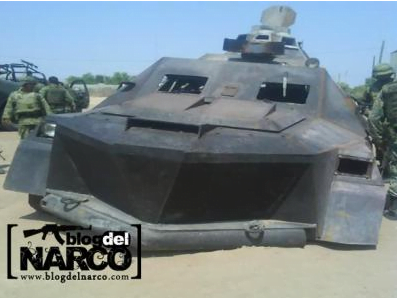Ed note. I’d like to welcome to the blog Diana Wueger, a freelance writer and nonprofit professional. She writes about international and domestic small arms issues at Gunpowder and Lead.
Evidence of the deepening entrenchment of Mexico’s drug war surfaced last week in the form of El Monstruo 2011, a homemade tank-like vehicle belonging to Los Zetas, the former enforcement arm of – and now competitor to – the powerful Gulf Cartel. Captured by the Mexican army after a firefight outside Ciudad Mier in northern Mexico, El Monstruo appears to be closer to an infantry fighting vehicle (IFV) than a traditional battle tank. It seems to have functioned as a combination direct fire vehicle and troop transport, carrying up to 12 people. The front openings would allow gunmen to use rifles and rocket-propelled grenades (RPGs); side portholes could be used for other small arms fire.
The addition of up-armored vehicles to the drug cartels’ fleets does not bode well for the Mexican government’s efforts to stem the escalating violence. While El Monstruo had a fatal design flaw – its tires were unshielded, leaving it vulnerable to bullets – the cartels’ increasing militarization suggests that President Calderon’s crackdown has sparked an internal arms race that will be difficult to deescalate. Also troubling is the cartels’ enhanced understanding of urban warfare tactics, possibly as a result of soldiers defecting; reports have surfaced of convoys successfully ambushing military patrols, and the use of car bombs and improvised explosive devices (IEDs) is on the rise.
Meanwhile, protests last Sunday demanding the resignation of Public Safety Secretary Garcia Luna echoed those of the Arab Spring:
“People are standing up to transform their societies in Egypt and in Syria. We have to do the same thing here — to change our country from the bottom up,” said Ruben Bueno, a 42-year-old school teacher, who said two of his students had been gunned down in the violence.
Luna has overseen the execution of Calderon’s military-led approach to fighting the cartels, which has drawn harsh criticism from academics, politicians, and activists alike. Nearly 40,000 have died in drug-related violence since the offensive was launched in December 2006, and while the government has succeeded in killing a number of drug gang leaders, there seems to be little progress in rolling back the cartels’ dominance. Last month was the bloodiest since Calderon took office, with over 1,400 killed nationwide, including more than 300 bodies found in mass graves in northern Mexico. Nevertheless, Calderon has stated that he will not change strategy in advance of the 2012 elections.

